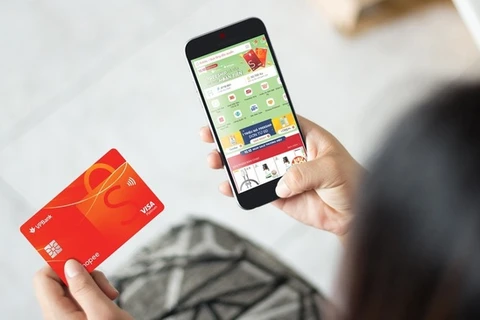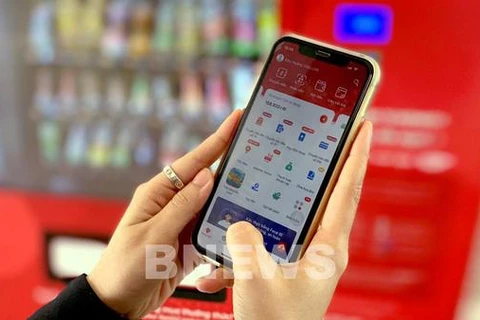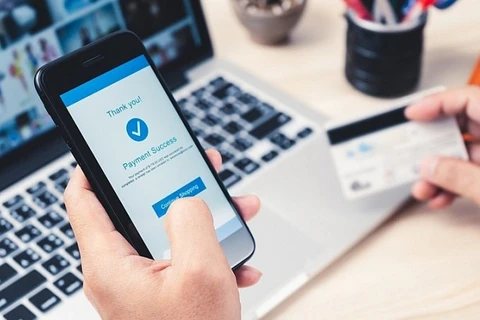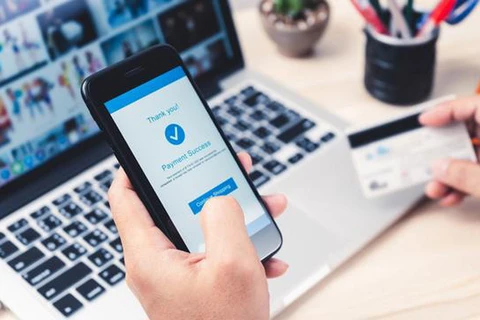Hanoi (VNS/VNA) - With a few clicks on an e-wallet platform installed on her mobile phone, Do Nhu Hoa, a 38-year-old office worker in Hanoi, can easily pay for her electricity and water bills.
Hoa said she got her e-wallet a year ago after some colleagues told her about its convenience. Now Hoa uses her e-wallet for most transactions.
"It is simple, easy and safe to use and it is free to top up or withdraw money from e-wallet to my bank accounts," Hoa said.
She said the e-wallet proved its efficiency amid the COVID-19 pandemic when she has to limit physical contact to stay safe.
Hoa is one of many Vietnamese customers who, since the start of the pandemic, now favour non-cash payments like e-wallets.
Thanh Trang, an employee of a private company in Hanoi, said using non-cash payment has become a habit of hers in recent years.
"I find cashless payment very convenient, now I rarely withdraw cash unless I pay for vegetables at the market and for my breakfast. Even when I forget my wallet or don't have small change left, I can transfer money to sellers via internet banking," Trang said.
"I'd rather forget my wallet than my phone when I hang out," Trang said, during the pandemic, cashless payment also helps reduce risks of infection, she added.
"The prolonged lockdowns keeping people at home, combined with consumers’ fear of catching COVID-19, has accelerated their preference toward using digital transactions. Up to 67 percent of Vietnamese consumers said they would like to use contactless payment whenever applicable," according to Thue Quist Thomasen, CEO of YouGov Vietnam.
At the same time, financial institutions have been competing to develop and provide the best digital platforms for their customers. Apps that are highly secured, user-friendly and fully integrated will encourage many Vietnamese consumers who are interested in trying the latest technology products, services and apps toward the digital transformation, he said.
"I believe that the cashless future for Vietnam is near," he added.
According to AppotaPay's forecast, the cashless payment market will grow strongly in the next three to five years. In particular, mobile money and e-wallets will be key services to help expand non-cash payments share in the Vietnamese market.
A recent report by the Government showed out that cashless payments continue to become more popular, topping 36.28 quadrillion VND (1.6 billion USD) in the first nine months of 2021.
During the period, 435.25 million transactions worth 22.78 quadrillion VND were made via the Internet, up 54.1 percent in volume and 30.7 percent in value. More than 1.19 billion others worth over 13.5 quadrillion VND were conducted via mobile phone, surging 74.98 percent in volume and 93.69 percent in value.
Businesses nationwide have made more than 90 percent of their tax payments via bank transfer. A large number of people have also used this method to pay power bills, medical examination and treatment fees or receive pensions and allowances.
However, payment frauds have also become more common across the country, the report pointed out.
Being a customer, Trang said she is concerned about scams, account stealing and identity theft when making non-cash payments. She suggests banks and app providers ensure payment security and safety.
In recent years, the Government has been facilitating cashless payments in the country.
On October 28, Deputy Prime Minister Le Minh Khai signed a decision to approve a project on developing Vietnam’s non-cash payment for the 2021-25 period.
The project aims to accelerate the growth of cashless payments in Vietnam and make cashless payment methods more popular to people in both urban and rural areas.
The project also intends to improve security, safety and confidentiality in non-cash payment activities, while improving the operational efficiency of the banking system and enhance the management of State agencies to ensure transparency. This will contribute to the fight again corruption, economic crimes and the prevention of money laundering.
The achievements of Industry 4.0 will also be implemented to upgrade cashless payment infrastructures that meet payment demands in a convenient and efficient method.
Under the project, cashless payment in e-commerce is estimated to reach 50 percent of total transactions by 2025.
Up to 80 percent of Vietnamese people from the age of 15 years old will have bank accounts, while the number of points accepting cashless payments will increase to over 450,000 by 2025.
In terms of public services, 90-100 percent of educational institutions in urban areas will accept the payment of tuition fees through non-cash transactions while 60 percent of medical examination and treatment establishments in urban areas will accept non-cash payment by 2025. Up to 60 percent of people in urban areas will receive their pensions, social insurance and unemployment benefits through this payment method.
As per the project, Vietnam also aims to achieve 20-25 percent growth rates in the number and value of non-cash payment transactions in the next four years.
It hopes to archive the respective average growth rates of 50-80 percent and 80-100 percent each year in the number and value of transactions via mobile phone, while that of transactions via the Internet is expected to grow 35-40 percent annually.
To this end, top priority should be given to completing the related legal corridor and policies, upgrading payment infrastructure to be able to connect and integrate with other systems, developing modern payment services and promoting non-cash payment in the public sector and others./.
Hoa said she got her e-wallet a year ago after some colleagues told her about its convenience. Now Hoa uses her e-wallet for most transactions.
"It is simple, easy and safe to use and it is free to top up or withdraw money from e-wallet to my bank accounts," Hoa said.
She said the e-wallet proved its efficiency amid the COVID-19 pandemic when she has to limit physical contact to stay safe.
Hoa is one of many Vietnamese customers who, since the start of the pandemic, now favour non-cash payments like e-wallets.
Thanh Trang, an employee of a private company in Hanoi, said using non-cash payment has become a habit of hers in recent years.
"I find cashless payment very convenient, now I rarely withdraw cash unless I pay for vegetables at the market and for my breakfast. Even when I forget my wallet or don't have small change left, I can transfer money to sellers via internet banking," Trang said.
"I'd rather forget my wallet than my phone when I hang out," Trang said, during the pandemic, cashless payment also helps reduce risks of infection, she added.
"The prolonged lockdowns keeping people at home, combined with consumers’ fear of catching COVID-19, has accelerated their preference toward using digital transactions. Up to 67 percent of Vietnamese consumers said they would like to use contactless payment whenever applicable," according to Thue Quist Thomasen, CEO of YouGov Vietnam.
At the same time, financial institutions have been competing to develop and provide the best digital platforms for their customers. Apps that are highly secured, user-friendly and fully integrated will encourage many Vietnamese consumers who are interested in trying the latest technology products, services and apps toward the digital transformation, he said.
"I believe that the cashless future for Vietnam is near," he added.
According to AppotaPay's forecast, the cashless payment market will grow strongly in the next three to five years. In particular, mobile money and e-wallets will be key services to help expand non-cash payments share in the Vietnamese market.
A recent report by the Government showed out that cashless payments continue to become more popular, topping 36.28 quadrillion VND (1.6 billion USD) in the first nine months of 2021.
During the period, 435.25 million transactions worth 22.78 quadrillion VND were made via the Internet, up 54.1 percent in volume and 30.7 percent in value. More than 1.19 billion others worth over 13.5 quadrillion VND were conducted via mobile phone, surging 74.98 percent in volume and 93.69 percent in value.
Businesses nationwide have made more than 90 percent of their tax payments via bank transfer. A large number of people have also used this method to pay power bills, medical examination and treatment fees or receive pensions and allowances.
However, payment frauds have also become more common across the country, the report pointed out.
Being a customer, Trang said she is concerned about scams, account stealing and identity theft when making non-cash payments. She suggests banks and app providers ensure payment security and safety.
In recent years, the Government has been facilitating cashless payments in the country.
On October 28, Deputy Prime Minister Le Minh Khai signed a decision to approve a project on developing Vietnam’s non-cash payment for the 2021-25 period.
The project aims to accelerate the growth of cashless payments in Vietnam and make cashless payment methods more popular to people in both urban and rural areas.
The project also intends to improve security, safety and confidentiality in non-cash payment activities, while improving the operational efficiency of the banking system and enhance the management of State agencies to ensure transparency. This will contribute to the fight again corruption, economic crimes and the prevention of money laundering.
The achievements of Industry 4.0 will also be implemented to upgrade cashless payment infrastructures that meet payment demands in a convenient and efficient method.
Under the project, cashless payment in e-commerce is estimated to reach 50 percent of total transactions by 2025.
Up to 80 percent of Vietnamese people from the age of 15 years old will have bank accounts, while the number of points accepting cashless payments will increase to over 450,000 by 2025.
In terms of public services, 90-100 percent of educational institutions in urban areas will accept the payment of tuition fees through non-cash transactions while 60 percent of medical examination and treatment establishments in urban areas will accept non-cash payment by 2025. Up to 60 percent of people in urban areas will receive their pensions, social insurance and unemployment benefits through this payment method.
As per the project, Vietnam also aims to achieve 20-25 percent growth rates in the number and value of non-cash payment transactions in the next four years.
It hopes to archive the respective average growth rates of 50-80 percent and 80-100 percent each year in the number and value of transactions via mobile phone, while that of transactions via the Internet is expected to grow 35-40 percent annually.
To this end, top priority should be given to completing the related legal corridor and policies, upgrading payment infrastructure to be able to connect and integrate with other systems, developing modern payment services and promoting non-cash payment in the public sector and others./.
VNA

























